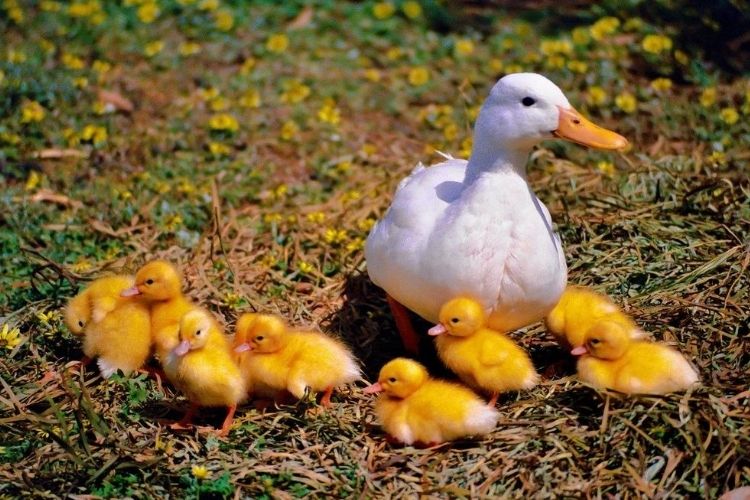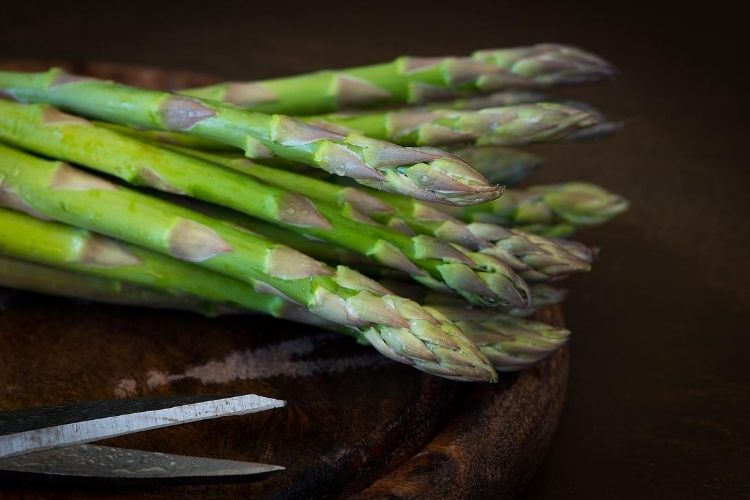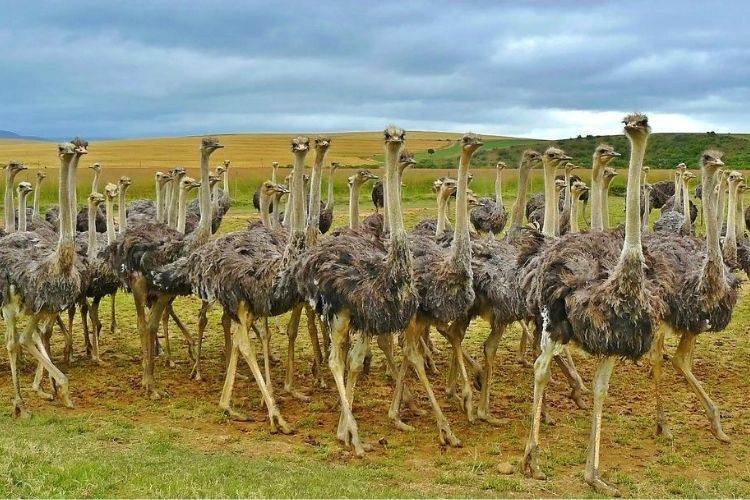
Keeping ducks at home means having a goal of getting early maturing meat or eggs. There are egg, meat-egg and meat breeds of ducks. Below is a description of some of the most popular breeds in private farmsteads.
Peking duck
It was bred in China 3 centuries ago. Today, among meat breeds, Peking duck is the most popular. These large white birds with an orange beak and legs are often bred on duck farms and in private households. Therefore, it will not be difficult to acquire young growth.
Adult males weigh about 4 kg, females reach 3-3.4 kg, the average weight of ducklings at the age of 2 months is 2.5 kg. Slaughter yield is 90% of live weight, edible part – 60-65%. During the year, the female brings about 100 eggs weighing 90 g, is able to hatch the offspring on her own, while hatching takes 4 weeks. They are unpretentious in keeping, survive the winter well and rarely get sick. Adult poultry meat is high in fat and slightly harsh. Birds are characterized by increased nervous excitability, so their breeding is accompanied by constant noise.
Muscovy ducks or Indo-duck
They are distinguished by a calm disposition. If something threatens them, then a hiss will be a defensive reaction. For this they are called “mutees”. It’s the very thing to grow them in the country, there will definitely not be any inconvenience. Indo-ducks are good mothers, they are often used to incubate eggs from ducks of other breeds, as well as turkey and chicken. On average, a healthy duck can lay 70-120 eggs per year.This breed is a domesticated species of wild South American ducks and is much inferior in early maturity to Peking. It will take 35-38 days to hatch the chicks, and the young reach a marketable weight of 2.5 kg in 3-3.5 months. An adult male weighs about 4 kg, a duck – 1.5 – 2 kg. However, the meat tastes good and contains a low percentage of fat. Muscovy eggs are a delicacy because they are low in cholesterol.
Mulard
A hybrid obtained by crossing a musky drake and a female mallard. The advantages include early maturity, a low percentage of adipose tissue and cleanliness. Literally, 2 months after hatching, the young are ready for slaughter. Like all interspecific hybrids, mulards cannot reproduce. Of course, they carry eggs, but there is no need to expect offspring from them. On the one hand, sterility is a disadvantage, and on the other, it is a virtue. After all, getting mulard ducklings can be a good business.
Room requirements
Keeping ducks is not difficult, but it is important to follow these rules:
- the height of the room should not be high, even 1 m is quite enough. On one square meter of area, 5 units of young animals or 3 adults can be placed;
- be sure to raise the floors 25 cm from ground level in order to avoid precipitation in the house, protect from rodents and keep warm;
- insulate the room, completely protect the bird from drafts, and in the cold season, the temperature in the room should be maintained at a level not lower than +5 degrees;
- pay attention to electric lighting. Remember: in winter, domestic ducks stop laying eggs when there is not enough warmth and when there is not enough lighting;
- on the south or southeast side, equip a hole 40×40 cm in size, install a tightly closing door in the opening;
- clean the house regularly, so I advise you to take care of your amenities in advance during cleaning;
- prepare a bedding in the form of hay, straw, sawdust;
- don’t forget about ventilation, which is necessary to prevent excessive humidity in winter and high temperatures in summer.
Inventory
Feeders are made of boards, everyone can handle this. It is important to make a secure and stable structure with a top bar to prevent birds from trampling and spilling feed.
Equip drinking bowls for each individual. Make sure that the water does not get dirty, otherwise you will have to constantly change it.
Set up nests in the yard where females will lay eggs. A 50x40x50 cm box filled with soft hay is perfect.
If there is a waterfowl on the farm, but there is no reservoir nearby, then make a small pond or pool, not necessarily in the ground, you can use a bath, a trough and other devices.
Maintenance of the parent flock
Anyone who breeds ducks at home is interested in speeding up the breeding process. What is required for this:
- the length of daylight hours within 16 hours;
- ambient temperature is not lower than 18 degrees.
- change the litter regularly, as contaminated eggs lose their hatching qualities;
- provide the bird with a calm environment, no repair work in the house and near the house;
- Diversify your diet and be sure to include mineral supplements in your diet. calcium in the form of chalk or broken shell is suitable – all this should be freely available.
Natural incubation
Make nests deep and use a thick layer of bedding. Preparing for the process, the duck does not leave the nest for a long time, with its paws in the litter it arranges a comfortable deep recess and pulls out the fluff for insulation.
Clutch should contain no more than 20 eggs. Caring for ducks during this period is thorough, but insignificant – rest and nutrition are important for them, especially those days when they stop leaving the nests altogether.
Artificial incubation
Breeding ducklings in an incubator is costly and troublesome. It is important to observe the special temperature and humidity level. If you also use budget models of the incubator, then you may have to turn the eggs 3 times a day by hand. And for culling, carried out on the 8th and 25th day, an ovoscope is required.
Assessment of offspring
To further successfully breed the bird, it is necessary to select healthy viable offspring. The selection is carried out according to the criteria:
- uniform color of down;
- wings pressed to the body;
- soft abdomen and no bleeding from the umbilical cord;
- shiny and prominent eyes.
Feeding little ducklings
From the first days, ducklings are fed with wet food – a slightly cooked mash of cereals, or starter food for young animals.
Alternately, you can give undercooked corn grits, chaff, millet … Wet bran and boiled eggs will not be superfluous – all this is finely crumbled. A week later, greens and peas soaked and twisted in a meat grinder are added to the diet (an excellent vegetable protein, thanks to which the young grows quickly).
If the third week has gone from the moment of birth, then yeast, ordinary fresh raw yeast for baking, can be safely introduced into the diet. The daily rate is not more than 3%. Fact: A bird that gets the yeast doesn’t fall to its feet!
From the third week, vegetables should also appear in the diet, chop them into small slices or grate them. It would be great to give the ducklings young nettles and zucchini. Chop the zucchini on a coarse grater and mix with a chop.
The daily rate is something like this:
- grain 45%
- food additives 25%
- greens and vegetables 20%
- protein food 15%
Prevention and treatment of diseases
From the age of one week, antibiotics need to be added to the water, enough twice with a break a week. You can use grisin, a wide spectrum of action.
Add fish oil to your food daily. It is worth stopping a month before the bird goes to meat in order to get rid of the smell.
When the bird reaches 3 kg, then it’s time to clean it up for meat, it makes no sense to keep them longer, it is not profitable! If the duck is sick, as a rule, it occurs due to unsanitary conditions, then it will be correct to give the duck to drink antibiotics. But again, pricking should be stopped a month before slaughter.
Important! When starting a duck business, try to manage a large number of birds, as keeping birds in small batches is not beneficial.







